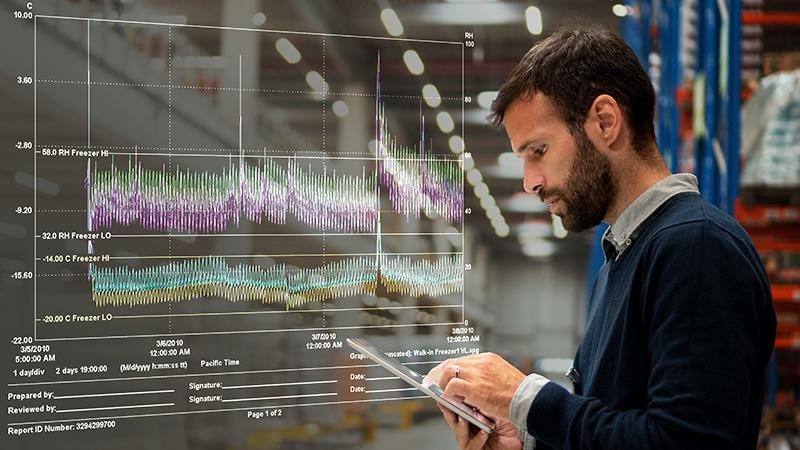Mapping study mix: vacuum ovens, warehouses, LN2 tanks, and CO2
After our webinar "Continuous Mapping" we received several questions:
Dear Paul,
We have multiple mapping applications. Please allow me to outline some of our approaches to you, so that I can get your feedback to implement potential improvements to our procedures.
Scenario 1:
We have a vacuum oven that has 10 shelves which generate heat. On each shelf there is a tray. Once the tray is too large to manage, we replace it with two smaller trays using the same available area.
An initial mapping is performed using the original large tray. Once that's done, we will replace that tray by two smaller in each shelf with the same material, should I repeat a mapping study with the two smaller trays?
Scenario 2:
Our warehouse has three years of routine mapping study data from mapping performed only during the summer. The summer is considered the worst-case period due the high temperatures. However, for our initial qualification, we performed both a winter and summer mapping. Those original studies also allowed us to define the monitoring probe’s location.
This is the current state:
• Monitoring Probes: one located on the hottest point and another on the coldest point.
• Monitoring Probe Position Re-assessment: Every three years.
My question is: once those two probes are connected to the monitoring system and we begin gathering data, can that be considered continuous mapping?
Scenario 3:
Based on your presentation, the three-year routine mapping studies to re-assess monitoring probe placement must consider the winter and summer seasonal period.
If two monitoring probes are installed in the extreme conditions locations and the summer is considered the worst-case period, why should we consider winter mappings going forward, after the initial winter studies?
Thanks in advance for your response!
- L
Paul wrote:
Thank you for joining our webinar and for asking great questions!
Scenario 1:
I will start by saying that mapping a vacuum oven is a validation or qualification of a dynamic process with a defined start and end, and product criteria (such as change in dryness or weight) that must be achieved by the end.
This is very different type of mapping process than mapping for storage. Just to be clear, the recommendations I gave in the webinar were for storage. Some of the principles cross over, of course, but please understand that the presentation was focused on mapping for storage. Nonetheless, I will try and answer your questions.
In the case of a vacuum oven, I would repeat the mapping. Using a different tray, of a different size, or a different material, will change how heat is transferred from the heated shelf to the tray, and could change the end performance and the amount of heat delivered to each product location.
Scenario 2:
This is not continuous mapping as outlined in the webinar. Yes, it is continuous, but it is not mapping. Mapping cannot be performed with only probe locations. I think you are assuming that the hot and cold spots will remain the same over time. You cannot prove this when you only gather data from two locations. Continuous mapping involves a high density of sensors continuously sampling.
Scenario 3:
Winter/Summer is better interpreted as “the most challenging seasons”, or “the hottest and coldest parts of the year”. If your cold season in your region is not cold enough to present a problem with your warehouse storage, then perhaps mapping is not needed in the winter. But you will still have to do something, such as provide a documented rationale why your facility doesn’t do winter mapping.
Overall:
I would question a decision to monitor a warehouse with only two sensors, one each in the identified hot/cold spots. This assumes that the warehouse’s temperature dynamics don’t change, except by season. But we know that warehouse conditions change for many reasons, for example, equipment failure, or personnel changing setpoints without following procedures, or doors accidentally left open.
Probably the most common activity that changes conditions is items being placed in a way that alters air flow and heat distribution. This alone affects where hot and cold spots are located and that can’t be detected by two sensors. Unless your warehouse is quite small (less than 100 cubic meters), I would add some additional monitoring locations. While you are expected to monitor the hot and cold spots, you are misinterpreting the guidance and the practice if you are monitoring ONLY the hot and cold spot.
Let me know of any follow-up questions!
Dear Paul,
As an industry practice, do we need to perform pre- and post-calibration checks performed before and after mapping studies for the following?
1. Vaisala Temperature/Humidity Loggers used in mapping environmental chamber
2. Vaisala CO2 Probes GMP251 and VL-4000-40C Analog Logger for CO2 chambers
3. Vaisala VL-170054T Thermocouple Logger for LN2 units
Paul wrote:
Thank you for these wide-ranging questions! I’ve tried my best to answer…
First, you asked about our Temperature/Humidity data loggers used in mapping environmental chambers.
In general, for any temperature sensor, you would perform a pre- and post-calibration check when mapping. This is not written in stone, but it is the general practice especially when using sensors with that tend drift with use, such as thermocouples.
It was the known tendency of thermocouples to drift in accuracy that created the practice of pre- and post-calibration. What we’ve seen is that older inspectors and auditors will expect to see this step. However, we do have mapping service providers as customers who use our loggers and they do not do pre- and post-calibration – they just verify the factory calibration certificate. This is based on the known stability of the devices as well as the experience of the provider. These service providers have enough experience with Vaisala products that they know how infrequently a mapping data logger will fail a calibration.
From our own internal studies, we see know our data loggers fail calibration it’s about 2% of the time. But since you don’t have this experience or data to rely on, I would just play it safe and do a simple documented pre- and post-cal. Nothing fancy, just put the mapping loggers (and a reference logger) in a small box in the space to be mapped for an hour, before and after the study, and show that all the values are within 0.2°C of the reference logger.
Your next question was on the CO2 Probes GMP251 and VL-4000-40C Analog data logger for CO2 chambers.
Technically, you won’t be mapping with these. Gases tend to diffuse so quickly that they reach equilibrium almost instantly, especially in a closed space. If you agree, then you are likely just measuring at a single point. If it was me, I would just verify that the chamber’s integrated CO2 sensor was calibrated.
But if you want to monitor CO2 independently during the mapping, I expect that some sort of calibration verification would be appropriate. Do you have any reason to expect that the CO2 sensor you plan to use would drift significantly during the study? If you don’t have a lot of historical data for CO2 sensors, it’s useful to do a pre-calibration and post-calibration
However, calibration of these devices is not as simple as with a temperature sensor, but there probably is a nice simple point of use check you can do if you have another calibrated instrument to use as reference. We aren’t looking for a full calibration here… just a quick documented check to show why you think the instrument is accurate.
Finally, you mentioned Vaisala VL-170054T Thermocouple Logger used in LN2 units. If you are mapping, especially with a thermocouple, I would definitely do a pre-calibration and post-calibration check. Again, this doesn’t have to be complicated, just enough to document the sensor’s accuracy.
Note that at liquid nitrogen temperatures, thermocouples have a lot of error. In my experience, mapping LN2 units is difficult. I had to map some LN2 storage dewars back in the day and we eventually managed to get it done. But we weren’t really able to conclude much, other than radially symmetric spaces are hard to map and the largest contributor to temperature variation were inherent insulation faults due to the method of construction of the vessel.


Add new comment